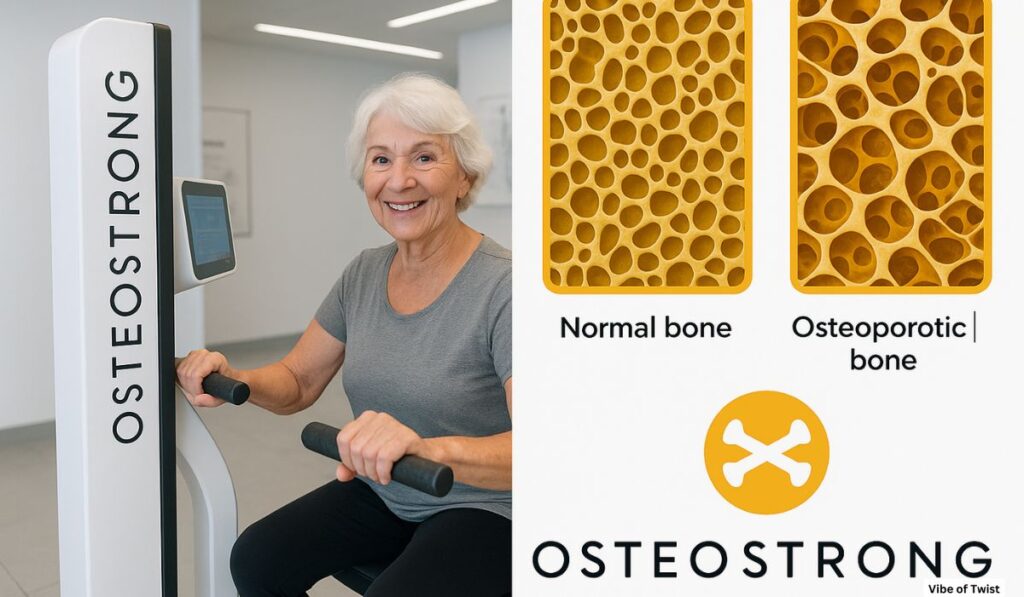OsteoStrong Review & Alternatives: Cost, Benefits, Safety & Results

You’ve probably heard the buzz about OsteoStrong — but is it really as revolutionary as it claims? Or is OsteoStrong a hoax?
That’s the big question many people are asking, especially those searching for ways to improve bone density naturally. With claims of helping users grow stronger bones through “once-a-week bone training” using cutting-edge machines, OsteoStrong is drawing attention from biohackers, seniors, and even athletes.
In this guide, we’ll walk you through everything you need to know: the benefits, cost, side effects, and OsteoStrong results, plus expert insights on alternatives like weight-bearing exercise and resistance training. We’ll also dive into the OsteoStrong controversy and real customer opinions. By the end, you’ll be able to decide if it’s a smart choice—or just clever marketing.
What is OsteoStrong and How Does it Work?
OsteoStrong is a wellness franchise built around a technology called osteogenic loading. This technique uses high-intensity machines that apply a safe but powerful force to the body, helping your bones and muscles grow stronger. The process mimics the effects of weight lifting, but without the wear and tear of traditional workouts.
Each session lasts about 10 minutes. You’ll use four robotic machines targeting different areas: legs, arms, core, and spine. There’s no sweating, no changing clothes, and no cardio. The goal is to trigger bone-building responses by pushing your body with brief, static contraction training.
Because of its non-invasive osteoporosis treatment approach, many call it a biohacking gym—especially those looking to build bone strength in a futuristic way.
Who Can Benefit from OsteoStrong?
OsteoStrong markets itself to a wide range of people. If you’re dealing with postmenopausal bone loss, osteopenia therapy, or looking for a safe exercise for seniors, you might be their ideal customer. Athletes use it to boost the muscle-bone connection, and others simply want to avoid breaking a hip later in life.
You could benefit from OsteoStrong if you’re seeking:
- Bone density improvement without lifting heavy weights
- Joint support without high-impact movements
- A new way to stay strong with minimal time
However, people with certain health conditions like recent fractures or spinal surgeries should consult a doctor. OsteoStrong is not a cure and shouldn’t replace medical care.
Does OsteoStrong Really Work? (Results & Reviews)
So, does OsteoStrong work? Users claim they’ve seen better posture, less joint pain, and improved bone scores on DEXA scan results. Testimonials often mention greater stability and confidence in daily movement.
But independent reviews are mixed. On sites like Reddit and Trustpilot, some users say the machines feel awkward or results are slow. Skeptics wonder, “is OsteoStrong legit?” Others ask, “is OsteoStrong a hoax?” due to bold marketing.
Research on OsteoStrong is limited. The company references data linked to John Jaquish OsteoStrong, the inventor behind the technology. However, most studies relate to the general principle of high-intensity isometric exercise, not OsteoStrong’s machines directly.
How Long Does It Take to See Results with OsteoStrong?
On average, the company says you’ll notice a change within 12–24 weeks. However, real-world users say it can take up to 6 months or longer. Don’t expect miracles in 2 sessions.
Weekly sessions create gradual bone strength, not instant results. You’ll track your measurable results over time through strength numbers and possible DEXA improvements. The biggest improvements often come in posture, balance, and joint stability first.
If you want to reverse bone loss naturally, patience is key. Some even combine it with osteoporosis supplements and dietary changes.
Is OsteoStrong Safe? Potential Risks & Side Effects
For most healthy adults, OsteoStrong is considered safe. The sessions are supervised, and you never use free weights. That makes it a safe osteoporosis workout, especially for those with bone fracture prevention in mind.
But there are possible concerns. The pressure applied might be too much for people with recent surgeries or fragile bones. And while it markets itself as a non-invasive osteoporosis treatment, it shouldn’t be mistaken for medical therapy.
Some online users even raise alarm about the OsteoStrong lawsuit filed in past years, citing misrepresentation. Always consult your doctor before starting.
OsteoStrong Cost: What You Need to Know
Let’s talk about money—because OsteoStrong cost isn’t cheap. Most locations in the U.S. charge between $129–$179/month, depending on your region. There may also be a one-time enrollment fee.
Here’s a quick comparison:
| Plan Type | Average Monthly Cost | Included Features |
| Basic Membership | $129 | 1 weekly session, performance tracking |
| Premium Membership | $159–179 | Extras like PEMF therapy, vibration plate |
| Personal Training (Gym) | $200–$400 | Traditional workouts with a live coach |
So, is OsteoStrong worth the price? It depends. If you value quick sessions and low-impact bone strengthening, maybe. But don’t expect coverage. Does Medicare or insurance cover OsteoStrong? No—because it’s not a medical procedure.
OsteoStrong vs Traditional Strength Training
Traditional strength training includes weight-bearing exercises like squats, deadlifts, and walking lunges. These are proven ways to build both muscle and bone.
With OsteoStrong, you skip the sweat and avoid injuries. But can it replace strength training for osteoporosis?
Let’s compare:
| Feature | OsteoStrong | Traditional Training |
| Time Commitment | 10 minutes/week | 3–5 sessions/week |
| Sweat Factor | Exercise without sweating | Heavy lifting and cardio involved |
| Impact on Muscles | Minimal muscle gain | Full muscle-building workouts |
| Bone Response | Bone-building exercise for seniors | Best exercise for bone density |
| Accessibility | Limited locations | Home or gym options |
Strength training vs OsteoStrong comparison shows that while OsteoStrong may suit seniors or busy professionals, others may benefit more from a traditional routine.
Top Alternatives to OsteoStrong for Stronger Bones
If you’re not sold on OsteoStrong, there are plenty of exercise alternatives to medication:
- Walking, stair climbing, hiking – great weight-bearing exercise
- Resistance bands – improve bone strength without heavy weights
- Yoga – enhances balance and flexibility for fracture risk reduction strategies
- Vibration plates – stimulate bone density (used in some clinics)
You could also try at-home apps like FitBod, Mighty Health, or YouTube videos tailored to strength building at home.
For those preferring offline help, look for a certified trainer who specializes in strength training for osteoporosis.
Pros and Cons of OsteoStrong
Let’s simplify it:
Pros:
- Low-impact bone strengthening
- Quick, once-a-week bone training
- Monitored, safe exercise for seniors
- Focus on bone health exercise without cardio
Cons:
- High cost, no insurance
- Limited locations
- Limited muscle-building potential
- Lack of peer-reviewed OsteoStrong research studies
Final Verdict: Is OsteoStrong Worth It?
So, is OsteoStrong a hoax or a helpful tool?
It’s not a scam—but it’s also not magic. If you’re looking for osteoporosis reversal without medication or static strength training without hitting the gym, OsteoStrong might be a fit. Just understand the limitations.
If you’re younger or already active, you may see better results from muscle building vs bone building workouts. But for busy seniors or people with mobility issues, this alternative to strength training offers convenience and potential bone density improvement.
Bottom line
Do your homework. OsteoStrong reviews vary widely, and what works for one body might not work for another. But now you’re ready to decide—with confidence.
FAQs
-
Is OsteoStrong scientifically proven?
It has some supportive studies, but the scientific evidence is limited and debated. -
Does Tony Robbins own OsteoStrong?
No, but he is a major partner and advocate. -
Does OsteoStrong increase bone density?
Some users report improvements, but results are anecdotal and not guaranteed. -
Who is the owner of OsteoStrong?
It is privately owned; Kyle Zagrodzky is the founder and president. -
Who invented OsteoStrong?
OsteoStrong was invented by John Jaquish, PhD, known for his work in osteogenic loading technology.
